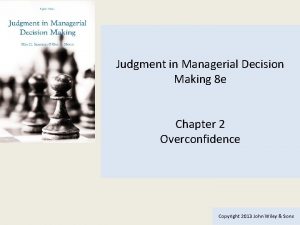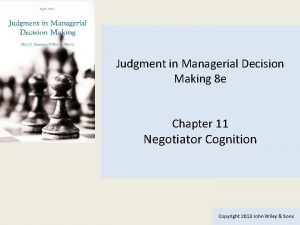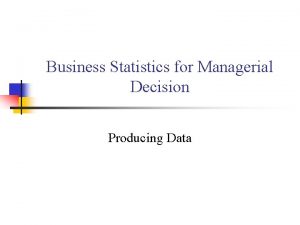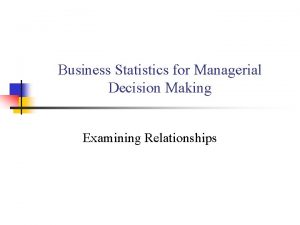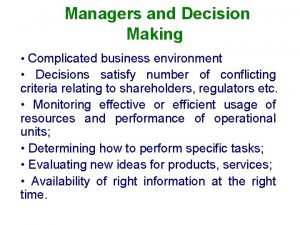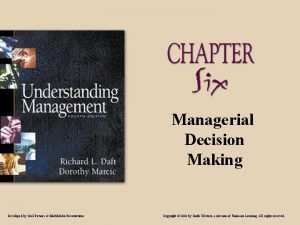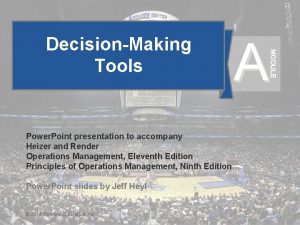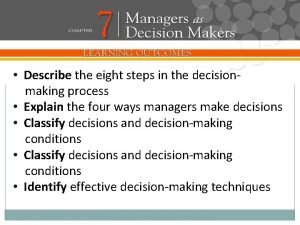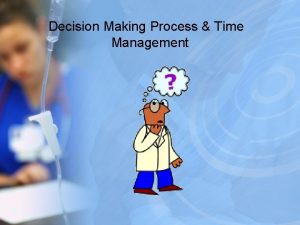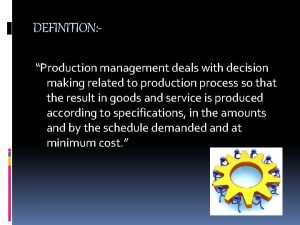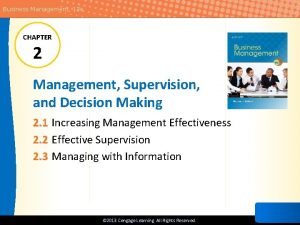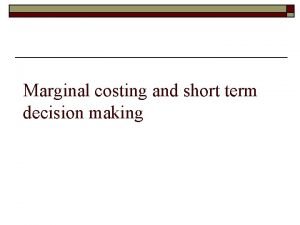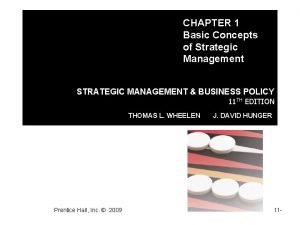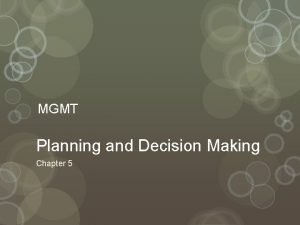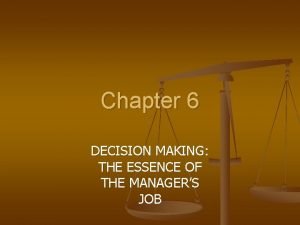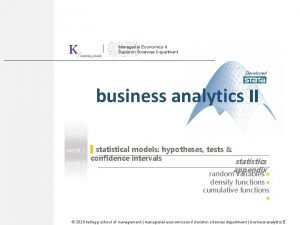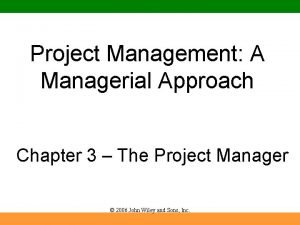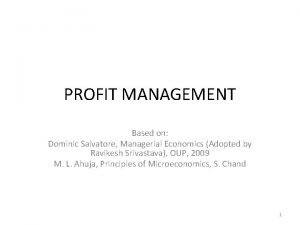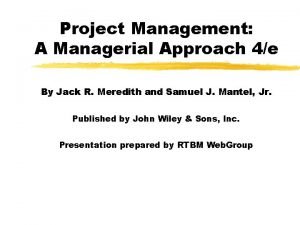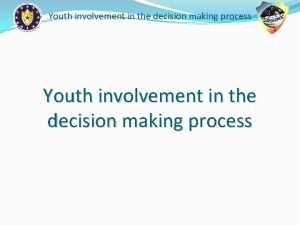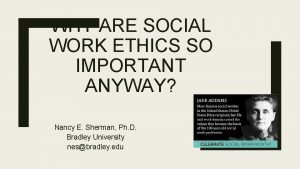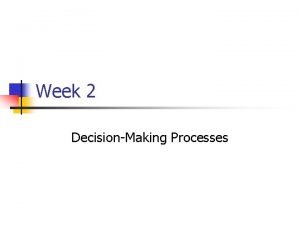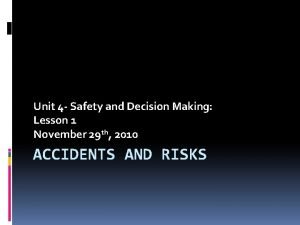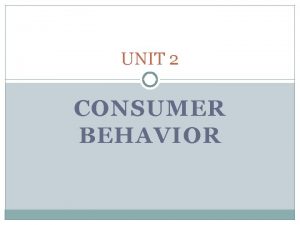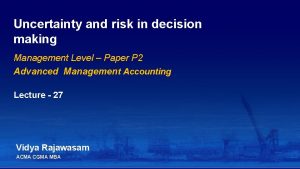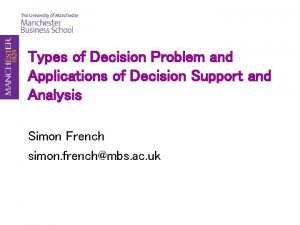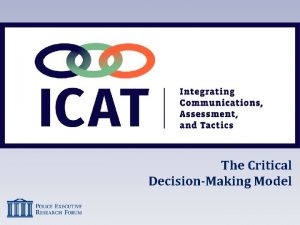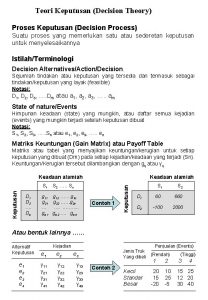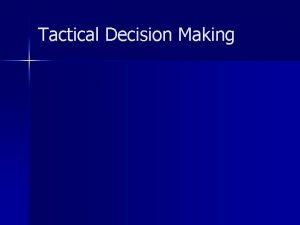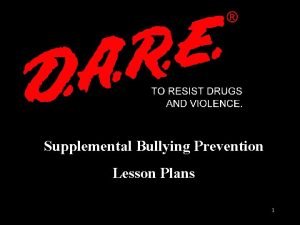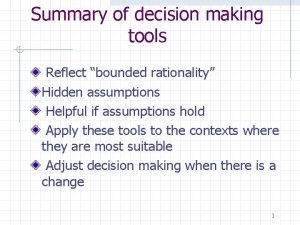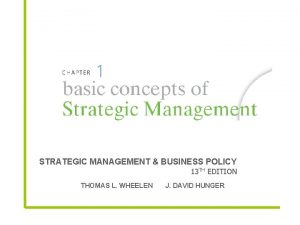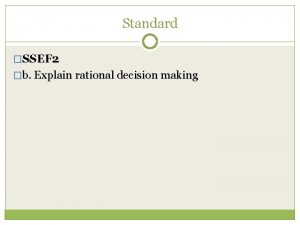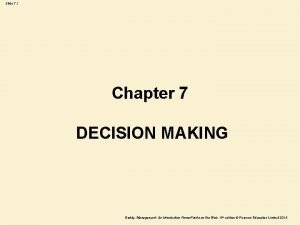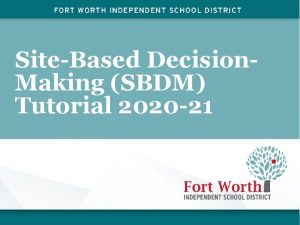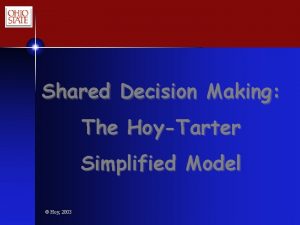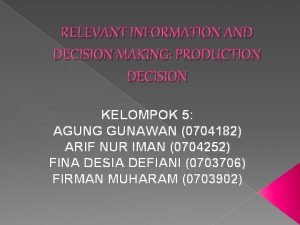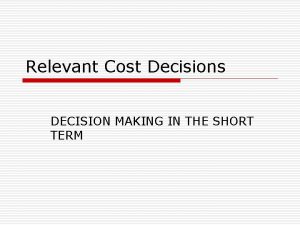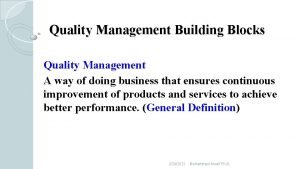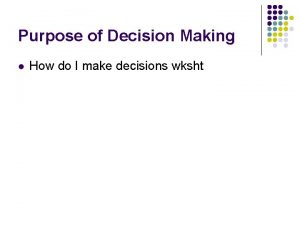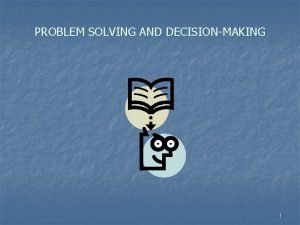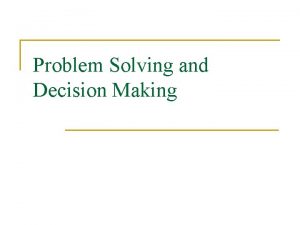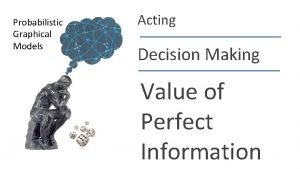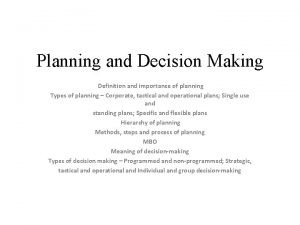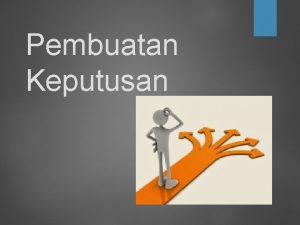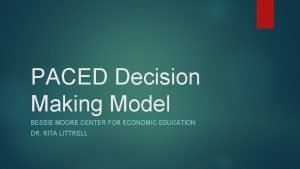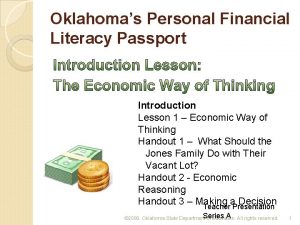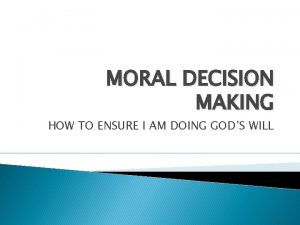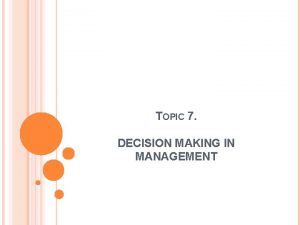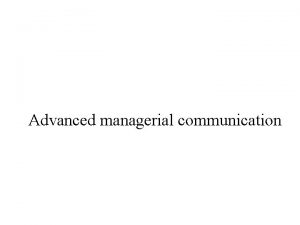TOPIC 7 DECISION MAKING IN MANAGEMENT MANAGERIAL DECISION



































































- Slides: 67

TOPIC 7. DECISION MAKING IN MANAGEMENT

MANAGERIAL DECISION MAKING Decision making: the process by which managers respond to opportunities and threats by analyzing options, and making decisions about goals and courses of action. Decisions in response to opportunities: managers respond to ways to improve organizational performance. Decisions in response to threats: occurs when managers are impacted by adverse events to the organization.

TYPES OF DECISION MAKING Programmed Decisions: routine, almost automatic process. Managers have made decision many times before. � There are rules or guidelines to follow. � Example: Deciding to reorder office supplies. � Non-programmed Decisions: unusual situations that have not been often addressed. No rules to follow since the decision is new. � These decisions are made based on information, and a manger’s intuition, and judgment. � Example: Should the firm invest in a new technology? �

THE CLASSICAL MODEL Classical model of decision making: a prescriptive model that tells how the decision should be made. Assumes managers have access to all the information needed to reach a decision. � Managers can then make the optimum decision by easily ranking their own preferences among alternatives. � Unfortunately, mangers often do not have all (or even most) required information.

THE CLASSICAL MODEL List alternatives & consequences Assumes all information is available to manager Rank each alternative from low to high Assumes manager can process information Select best alternative Assumes manager knows the best future course of the organization

THE ADMINISTRATIVE MODEL Administrative Model of decision making: Challenges the classical assumptions that managers have and process all the information. � As a result, decision making is risky. l Bounded rationality: There is a large number of alternatives and information is vast so that managers cannot consider it all. � Decisions are limited by people’s cognitive abilities. l Incomplete information: most managers do not see all alternatives and decide based on incomplete information.

WHY INFORMATION IS INCOMPLETE Uncertainty & risk Ambiguous Information Incomplete Information Time constraints & information costs

DECISION MAKING STEPS Recognize need for a decision Frame the problem Generate & assess alternatives Choose among alternatives Implement chosen alternative Learn from feedback

DECISION MAKING STEPS 1. Recognize need for a decision: Managers must first realize the need for which a decision must be made.

DECISION MAKING STEPS Recognize need for a decision Frame the problem Generate & assess alternatives Choose among alternatives Implement chosen alternative Learn from feedback

DECISION MAKING STEPS 2. Frame the problem: managers must frame problem for which decision is to be made.

FISHBONE DIAGRAM Ø When should a fishbone diagram be used? Ø Need to study a problem/issue to determine the root cause? Ø Want to study all the possible reasons why a process is beginning to have difficulties, problems or breakdown? Ø Need to identify areas for data collection? Ø Want to study why a process is not performing properly or producing the desired results?

HOW TO CONSTRUCT A FISHBONE DIAGRAM ? Ø Ø Draw the Fishbone diagram……. . List the problem/Issue to be studied in the “Head of the Fish”. Label each “Bone” of the “Fish”. The major categories typically utilized are: The 4 M’s: Ø Ø The 4 P’s: Ø Ø Methods, Machines, Materials & Manpower. Place, Procedure, People & Policies. The 4 S’s: Ø Surroundings, Suppliers, Systems & Skills. Note: You may use one of the 4 categories suggested, combine them in any fashion or make up your own. The categories are to help you to organize your ideas.

THE 5 W’S?

HOW TO COMPLETE THE 5 WHYS? 1. Write down the specific problem. Writing the issue helps you to formulize the problem and describe it completely. It also helps a team focus on the same problem. 2. Ask Why the problem occurs? And write the answer down below the problem. 3. If the answer you just provided doesn’t identify the root cause of the problem that you wrote down in step 1, ask Why again and write that answer down. 4. Loop back to Step 3 until the team is in agreement that the problem’s root cause is identified. Again, this may take few or more times than 5 Whys



TYPES OF FLOW CHARTS Ø Linear Flowchart Ø Deployment Flowchart Ø Opportunity Flowchart

LINEAR FLOWCHAT Collect Inputs Start Draft Circular Type Rough Submit to A Retype Stop OK Final Draft Signature (A) Make Copies Distribute

PROCESS FLOWCHAT


CORRELATION ANALYSIS

DECISION MAKING STEPS Recognize need for a decision Frame the problem Generate & assess alternatives Choose among alternatives Implement chosen alternative Learn from feedback

DECISION MAKING STEPS 3. Generate alternatives: managers must develop feasible alternative courses of action. If good alternatives are missed, the resulting decision is poor. It is hard to develop creative alternatives, so managers need to look for new ideas. Evaluate alternatives: what are the advantages and disadvantages of each alternative? Managers evaluate. should specify criteria, then

TIPS FOR GENERATING ALTERNATIVES Ø Brainstorming. Ø Involve Outsiders. Ø External Benchmarking Ø Encourage members to step out of their traditional roles. Ø Ask probing questions. Ø Be willing to consider views differing from yours. Ø Revisit abandoned alternatives.

WHAT IS VERTICAL THINKING? ? Ø Basing our thought process on prior knowledge and experience. Ø Using logic that relates only to our immediate experience. Ø Constraining our creativity ability to solve problems. and

WHAT IS LATERAL THINKING? ? Ø Changing Orientation perception. and Ø Generating Visions. and Ø Exploring multiple possibilities and approaches. New Ideas

OBSERVATION B/W LATERAL & VERTICAL THINKING Ø Vertical Thinking is selective. Ø One may reach a conclusion by a valid series of steps. Ø Lateral Thinking is generative. Ø Vertical thinking develops the ideas generated by lateral thinking.

DECISION MAKING STEPS Recognize need for a decision Frame the problem Generate & assess alternatives Choose among alternatives Implement chosen alternative Learn from feedback

DECISION MAKING STEPS 4. Choose among alternatives: managers rank alternatives and decide. While ranking, all information needs to be considered.

EVALUATING ALTERNATIVES Is the possible course of action: Legal? Ethical ? Economical? Practical?

DECISION MAKING STEPS Recognize need for a decision Frame the problem Generate & assess alternatives Choose among alternatives Implement chosen alternative Learn from feedback

DECISION MAKING STEPS 5. Implement choose alternative: managers must now carry out the alternative. Often a decision is made and not implemented.

DECISION MAKING STEPS Recognize need for a decision Frame the problem Generate & assess alternatives Choose among alternatives Implement chosen alternative Learn from feedback

DECISION MAKING STEPS 6. Learn from feedback: managers should consider what went right and wrong with the decision and learn for the future. Without feedback, managers never learn from experience and might repeat the same mistake.

DECISION MAKING STEPS Recognize need for a decision Frame the problem Generate & assess alternatives Choose among alternatives Implement chosen alternative Learn from feedback

WHAT FACTORS DO INFLUENCE DECISION MAKING PROCESS? Ø Technology. Ø Culture. Ø Ethics.

HOW DO TECH. , CULTURE & ETHICS INFLUENCE DECISION MAKING? Ø Increasingly complex problems and opportunities face decision makers in organizations due to various workplace trends. Ø These workplace trends are changing the Who, When, Where, and How of decision making. IT and Decision Making Ø Artificial Intelligence: The study of how computers can be programmed to think like human beings. Ø Will allow computers to displace many decision makers. Ø Ø Expert systems that support decision making following “Either – or” rules to make deductions. by

HOW DO TECH. , CULTURE & ETHICS INFLUENCE DECISION MAKING? Ø Fuzzy Logic and Neural Networks. Ø Computer support for decision making: The Internet Ø The Intranet Ø Decision support software. Ø Virtual Team work. Ø

EVALUATING ALTERNATIVES Is it legal? Managers must first be sure that an alternative is legal both in this country and abroad for exports. Is it ethical? The alternative must be ethical and not hurt stakeholders unnecessarily. Is it economically feasible? Can our organization’s performance goals sustain this alternative? Is it practical? Does the management have the capabilities and resources to do it?

COGNITIVE BIASES Suggests decision makers use heuristics to deal with bounded rationality. �A heuristic is a rule of thumb to deal with complex situations. � If the heuristic is wrong, however, then poor decisions result from its use. Systematic heuristic. � errors can result from use of an incorrect These errors will appear over and over since the rule used to make decision is flawed.

TYPES OF COGNITIVE BIASES Prior Hypothesis Representativeness Illusion of Control Escalating Commitment Cognitive Biases

TYPES OF COGNITIVE BIASES Prior hypothesis bias: manager allows strong prior beliefs about a relationship between variables and makes decisions based on these beliefs even when evidence shows they are wrong. Representativeness: decision maker incorrectly generalizes a decision from a small sample or one incident. Illusion of control: manager over-estimates their ability to control events. Escalating commitment: manager has already committed considerable resource to project and then commits more even after feedback indicates problems

TYPES OF DECISION IN ORGANIZATION Ø Strategic Decision. Ø Business Decision. Ø Operational Decision

HOW ARE DECISIONS MADE IN ORGANIZATIONS? Decision making: Ø The process of choosing a course of action for dealing with a problem or opportunity.

DECISION MAKING Ø Environment Ø Decision Making Models Ø Decision Making Realities Ø Authorities in Decision Making Ø Influencing Factors in Decision Making Ø 7 Cs

HOW ARE DECISIONS MADE IN ORGANIZATIONS? Decision Environments Include: Ø Certain environment § Exist when information is sufficient to predict the results of each alternative in advance of implementation. § Certainty is the ideal problem solving and decision making environment Ø § § Risk environment Exist when decision maker lack complete certainty regarding the outcome of various courses of action, but can assign probabilities of occurrence. Probabilities can be assigned through objective statistical procedures or personal institution.

HOW ARE DECISIONS MADE IN ORGANIZATIONS? Decision Environments Include: Ø Uncertain environment Ø Exist when managers have so little information that they cannot even assign probabilities to various alternatives and possible outcomes. Ø Uncertainty forces decision makers to rely on individual and group creativity to success over the problem. Ø Also characterized by rapidly changing : § External Conditions § IT requirements § Personnel Influencing problem and choice definition. Ø These rapid changes are also called organized anarchy.

DECISION THEORY Ø Classical Decision Theory. Ø Behavioral Decision Theory.

WHAT ARE THE USEFUL DECISION MAKING MODELS? Ø Classical Decision Theory: Views the decision maker as acting in a world of complete certainty. Ø Behavioral Decision Theory: Accepts a world with bounded rationality and views the decision maker as acting only in terms of what he/she perceives about a given situation

THE CLASSICAL DECISION MAKING MODELS? Ø Classical Decision Theory: The Classical Decision Maker: Faces a clearly defined problem. ü Knows all possible action alternatives and their consequences. ü Chooses the optimum alternative. ü It is often used as a model of how Managers should make decisions:

THE BEHAVIORAL DECISION MAKING MODELS? Ø Behavioral Decision Theory: Recognizes that human beings operate with: ü Cognitive Limitations. ü Bounded Rationality. The Behavioral Decision maker: ü Faces a problem that is not clearly defined. ü Has limited knowledge of possible alternatives and their consequences. ü Chooses a satisfactory alternative. action

WHAT ARE THE USEFUL DECISION MAKING MODELS? Ø Classical Decision Theory: May not fit well in a chaotic world. Can be used towards the bottom of many firms, even most high-tech firms. Ø Behavioral Decision Theory: Fits with a chaotic world of uncertain conditions and limited information. Encourages satisfying decision making.

AUTHORITY IN DECISION MAKING Ø Deciding who should participate: Ø Authority Decisions Ø Made by the Manager or TL without involving other people and by using information that he / she possess. Ø Consultative Decisions. Ø Made by one individual after seeking input from group members. Ø Group Decisions Ø Made by all members of the group.

GROUP DECISION MAKING Many decisions are made in a group setting. � Groups tend to reduce cognitive biases and can call on combined skills, and abilities. There are some disadvantages with groups: Group think: biased decision making resulting from group members striving for agreement. Usually occurs when group members rally around a central manger’s idea (CEO), and become blindly committed without considering alternatives. � The group tends to convince each member that the idea must go forward. �

IMPROVED GROUP DECISION MAKING Devil’s Advocacy: one member of the group acts as the devil’s advocate and critiques the way the group identified alternatives. � Dialectical inquiry: two different groups are assigned to the problem and each group evaluates the other group’s alternatives. � Points out problems with the alternative selection. Top managers then hear each group present their alternatives and each group can critique the other. Promote diversity: by increasing the diversity in a group, a wider set of alternatives may be considered.

DEVIL’S ADVOCACY V. DIALECTIC INQUIRY Devil’s Advocacy Presentation of alternative Critique of alternative Reassess alternative accept, modify, reject Dialectic Inquiry Alter. 1 Alter. 2 Debate the two alternatives Reassess alternatives accept 1 or 2, combine

ORGANIZATIONAL LEARNING & CREATIVITY Organizational Learning: Managers seek to improve member’s ability to understand the organization and environment so as to raise effectiveness. � The learning organization: managers try to improve the people’s ability to behave creatively to maximize organizational learning. Creativity: is the ability of the decision maker to discover novel ideas leading to a feasible course of action. � A creative management staff and employees are the key to the learning organization.

SIX C’S OF DECISION MAKING Ø Construct. Ø Compile. Ø Collect. Ø Compare. Ø Consider. Ø Commit.

SIX C’S OF DECISION MAKING Ø Construct a clear picture of precisely what must be decided. Ø Compile a list of requirements that must be met. Ø Collect information on alternatives that meet the requirements.

SIX C’S OF DECISION MAKING Ø Compare alternatives that meet the requirements. Ø Consider the “What might go wrong” factor with each alternative. Ø Commit to a decision and stick to it.

INHERENT SYSTEM: TRAPS Ø Trying too hard to play it safe. Ø Letting fears and biases, thinking and analysis. Ø Getting lost in the minute aspects. Ø Craving unanimous approval. Ø Trying to make decisions which are outside your realm of authority. tilt your

INHERENT SYSTEM: TRAPS Ø Willing to begin with too little, inaccurate, or wrong information. Ø Overlooking viable alternatives or wasting time considering alternatives which have no realistic prospects. Ø Not following the 6 C’s. Ø Failing to clearly define the results you expect to achieve. Ø Worst of all, failing to reach a decision.

FINANCIAL TOOLS FOR EVALUATING ALTERNATIVES Ø ROI Ø Pay Back Ø NPV (Net Present Value) Ø IRR (Internal Rate of Return) Ø BEA (Break Even Analysis) Ø SA (Sensitivity Analysis)

IMPLEMENT PROCESS Ø Communicate Ø Train Ø Plan Ø Do Ø Check Ø Act Ø Execute Ø Review

COMPLEX PROBLEM SOLVING PROCEDURE Ø Measure Ø Model Ø Understand Ø Predict/Decide/ Plan Ø Communicate Ø Act

COMPLEX PROBLEM SOLVING
 Judgement in managerial decision making
Judgement in managerial decision making Mythical fixed pie assumption
Mythical fixed pie assumption Managerial versus entrepreneurial decision making
Managerial versus entrepreneurial decision making Statistics for managerial decision making
Statistics for managerial decision making Statistics for managerial decision making
Statistics for managerial decision making Objectives of decision making
Objectives of decision making Dividend decision in financial management
Dividend decision in financial management Types of decision making
Types of decision making Types of decision making in management
Types of decision making in management Management chapter 5 planning and decision making
Management chapter 5 planning and decision making Decision making tools in management ppt
Decision making tools in management ppt Eight step decision making model
Eight step decision making model Decision making process definition
Decision making process definition Production decision definition
Production decision definition Chapter 2 management supervision and decision making
Chapter 2 management supervision and decision making Introduction of marginal costing
Introduction of marginal costing Basic concepts of strategic management
Basic concepts of strategic management Options-based planning
Options-based planning What is the essence of decision making
What is the essence of decision making Managerial decision problems
Managerial decision problems Managerial economics and decision sciences
Managerial economics and decision sciences Lead paragraph example
Lead paragraph example Topic about internet
Topic about internet What is inference
What is inference War making and state making as organized crime
War making and state making as organized crime Project management a managerial approach
Project management a managerial approach Group managerial approach in classroom management
Group managerial approach in classroom management Profit management in managerial economics
Profit management in managerial economics Project management a managerial approach
Project management a managerial approach Youth involvement
Youth involvement Social work code of ethics
Social work code of ethics Systematic decision making process
Systematic decision making process Paced decision making
Paced decision making Mamdm
Mamdm Using recursion in models and decision making sheet 3
Using recursion in models and decision making sheet 3 Defining moments
Defining moments Unit 4 lesson 1 decision making
Unit 4 lesson 1 decision making Decision making unit example
Decision making unit example Types of decision making
Types of decision making Pestec higher business
Pestec higher business Decision making unit example
Decision making unit example Unstructured decision making
Unstructured decision making Role of marketing research in decision making
Role of marketing research in decision making Ask model
Ask model Decision theory adalah
Decision theory adalah Tactical decision making
Tactical decision making What is the dare decision making model
What is the dare decision making model Decision making summary
Decision making summary Mintzberg's modes of strategic decision making
Mintzberg's modes of strategic decision making Paced decision making
Paced decision making Chapter 6 prices and decision making assessment answers
Chapter 6 prices and decision making assessment answers Decision making conditions
Decision making conditions Sbdm roles and responsibilities
Sbdm roles and responsibilities Model hoy
Model hoy Decision making and relevant information
Decision making and relevant information Steps in decision making
Steps in decision making Building blocks of quality
Building blocks of quality Abcde decision making model
Abcde decision making model Reasoning judgement decision making relaxing
Reasoning judgement decision making relaxing Best books on problem solving and decision making
Best books on problem solving and decision making Individual and group decision making
Individual and group decision making What graphical model is appropriate for decision making
What graphical model is appropriate for decision making Importance of decision making
Importance of decision making Habitual decision making adalah
Habitual decision making adalah List the steps in the paced decision making process
List the steps in the paced decision making process Paced decision making
Paced decision making Stop method of moral decision making
Stop method of moral decision making Consumer decision making process
Consumer decision making process
